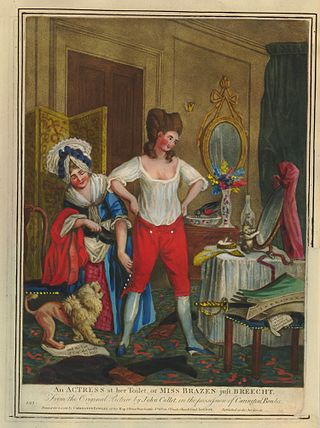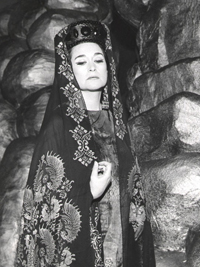A coloratura soprano is a type of operatic soprano voice that specializes in music that is distinguished by agile runs, leaps and trills.
The term coloratura refers to the elaborate ornamentation of a melody, which is a typical component of the music written for this voice. Within the coloratura category, there are roles written specifically for lighter voices known as lyric coloraturas and others for larger voices known as dramatic coloraturas. Categories within a certain vocal range are determined by the size, weight and color of the voice. Coloratura is particularly found in vocal music and especially in operatic singing of the 18th and 19th centuries. The word coloratura ( UK: /ˌkɒlərəˈtjʊərə/ COL-ə-rə-TURE-ə, US: /ˌkʌl-/ CUL-, Italian: [koloraˈtuːra] ) means 'coloring' in Italian, and derives from the Latin word colorare 'to color'. [1]
A very agile light voice with a high upper extension, capable of fast vocal coloratura. Lyric coloraturas have a range of approximately middle C (C4) to "high F" (F6). Such a soprano is sometimes referred to as a soprano leggero if her vocal timbre has a slightly warmer quality. The soprano leggero also typically does not go as high as other coloraturas, peaking at a "high E" (E6). [2] Bel canto roles were typically written for this voice, and a wide variety of other composers have also written coloratura parts. Baroque music, early music and baroque opera also have many roles for this voice. [3]
Source: [3]
A coloratura soprano with great flexibility in high-lying velocity passages, yet with great sustaining power comparable to that of a full spinto or dramatic soprano. Dramatic coloraturas have a range of approximately "low A" (A3) to "high F" (F6). Various dramatic coloratura roles have different vocal demands for the singer – for instance, the voice that can sing Abigail (Nabucco, Verdi) is unlikely to also sing Lucia (Lucia di Lammermoor, Donizetti), but a factor in common is that the voice must be able to convey dramatic intensity as well as flexibility. Roles written specifically for this kind of voice include the more dramatic Mozart and bel canto female roles and early Verdi. [4] This is a rare vocal fach, as thick vocal cords are needed to produce the large, dramatic notes, which usually lessens the flexibility and acrobatic abilities of the voice.
Source: [3]
In rare instances, some coloratura sopranos are able to sing in altissimo above high F (F6). This type of singer is sometimes referred to as a soprano acuto sfogato. [5]
Although both lyric and dramatic coloraturas can be acuto sfogato sopranos, the primary attribute of the acuto sfogato soprano is an upper extension above F6. [6] Some pedagogues refer to these extreme high notes as the whistle register.
Very few composers have ever written operatic roles for this voice type with actual notes scored above high F, so these singers typically display these extreme high notes through the use of interpolation in some of the operatic roles already cited above or in concert works. Examples of works that include G6 are the concert aria "Popoli di Tessaglia!"" by Mozart, Esclarmonde by Massenet, and Postcard from Morocco by Dominick Argento. Thomas Adès composed a high A (A6) for the character of Leticia Meynar in The Exterminating Angel .
The soprano acuto sfogato is sometimes confused with the soprano sfogato, a singer (often mezzo-soprano) capable, by sheer industry or natural talent, of extending her upper range to encompass some of the coloratura soprano tessitura, though not the highest range above high F.
A soprano is a type of classical female singing voice and has the highest vocal range of all voice types. The soprano's vocal range (using scientific pitch notation) is from approximately middle C (C4) = 261 Hz to "high A" (A5) = 880 Hz in choral music, or to "soprano C" (C6, two octaves above middle C) = 1046 Hz or higher in operatic music. In four-part chorale style harmony, the soprano takes the highest part, which often encompasses the melody. The soprano voice type is generally divided into the coloratura, soubrette, lyric, spinto, and dramatic soprano.
A tenor is a type of classical male singing voice whose vocal range lies between the countertenor and baritone voice types. It is the highest male chest voice type. Composers typically write music for this voice in the range from the second B below middle C to the G above middle C (i.e. B2 to G4) in choral music, and from the second B flat below middle C to the C above middle C (B♭2 to C5) in operatic music, but the range can extend at either end. Subtypes of tenor include the leggero tenor, lyric tenor, spinto tenor, dramatic tenor, heldentenor, and tenor buffo or spieltenor.
A contralto is a type of classical female singing voice whose vocal range is the lowest female voice type.
A mezzo-soprano or mezzo (; Italian:[ˌmɛddzosoˈpraːno]; meaning "half soprano") is a type of classical female singing voice whose vocal range lies between the soprano and the contralto voice types. The mezzo-soprano's vocal range usually extends from the A below middle C to the A two octaves above (i.e. A3–A5 in scientific pitch notation, where middle C = C4; 220–880 Hz). In the lower and upper extremes, some mezzo-sopranos may extend down to the F below middle C (F3, 175 Hz) and as high as "high C" (C6, 1047 Hz). The mezzo-soprano voice type is generally divided into the coloratura, lyric, and dramatic.

Vesselina Kasarova is a Bulgarian operatic mezzo-soprano.
The German Fach system is a method of classifying singers, primarily opera singers, according to the range, weight, and color of their voices. It is used worldwide, but primarily in Europe, especially in German-speaking countries and by repertory opera houses.

A breeches role is one in which an actress appears in male clothing. Breeches, tight-fitting knee-length pants, were the standard male garment at the time these roles were introduced. The theatrical term travesti covers both this sort of cross-dressing and also that of male actors dressing as female characters. Both are part of the long history of cross-dressing in music and opera and later in film and television.

Ayşe Leyla Gencer was a Turkish operatic soprano.

A soubrette is a female minor stock character in opera and theatre, often a pert lady's maid. By extension, the term can refer generally to any saucy or flirtatious young woman. The term arrived in English from Provençal via French, and means "conceited" or "coy".

Patrizia Ciofi is an Italian operatic coloratura soprano.
Dilber Yunus is a Uyghur lyric soprano with coloratura technique. She has been called the "Philomela of China," in reference to the Athenian King Pandion I's daughter, who, according to legend, turned into a nightingale. She is a citizen of Finland.

Diana Damrau is a German soprano who achieved international fame for her performances, primarily in opera, but also in concert and lieder. She has been successful in coloratura soprano roles since her early career, and gradually proceeded into heavier roles of the 19th-century Italian bel canto repertoire. Her signature roles include the Queen of the Night in The Magic Flute, Zerbinetta in Ariadne auf Naxos, Lucia in Lucia di Lammermoor, and Violetta in La traviata.
A spinto soprano is a type of operatic soprano voice that has the limpidity and easy high notes of a lyric soprano, yet can be "pushed" on to achieve dramatic climaxes without strain. This type of voice may also possess a somewhat darker timbre than the average lyric.
A dramatic soprano is a type of operatic soprano with a powerful, rich, emotive voice that can sing over, or cut through, a full orchestra. Thicker vocal folds in dramatic voices usually (but not always) mean less agility than lighter voices but a sustained, fuller sound. Usually this voice has a lower tessitura than other sopranos, and a darker timbre. They are often used for heroic, often long-suffering, tragic women of opera. Dramatic sopranos have a range from approximately low A (A3) to "high C" (C6). Some dramatic sopranos, known as Wagnerian sopranos, have an exceptionally big voice that can assert itself over a large orchestra (of more than 80 or even 100 players). These voices are substantial, often denser in tone, extremely powerful and, ideally, evenly balanced throughout the vocal registers. Wagnerian sopranos usually play mythic heroines. Successful Wagnerian sopranos are rare and often Wagnerian roles are performed by Italianate dramatic sopranos.

Joyce DiDonato is an American lyric-coloratura mezzo-soprano. She is notable for her interpretations of operas and concert works in the 19th-century romantic era in addition to works by Handel and Mozart.
A lyric soprano is a type of operatic soprano voice that has a warm quality with a bright, full timbre that can be heard over an orchestra. The lyric soprano voice generally has a higher tessitura than a soubrette and usually plays ingenues and other sympathetic characters in opera. Lyric sopranos have a range from approximately middle C (C4) to "high D" (D6). There is a tendency to divide lyric sopranos into two groups: light and full.

Gail Robinson was an American operatic soprano who sang with many of the world's leading opera companies during the 1970s and 1980s. She spent most of her career singing lyric coloratura roles at the Metropolitan Opera. After her performance career ended she taught singing to young artists and also directed the Metropolitan Opera's Young Artist Program for over ten years. Upon leaving the Met, she joined the voice faculty at the University of Kentucky.
A bass is a type of classical male singing voice and has the lowest vocal range of all voice types. According to The New Grove Dictionary of Opera, a bass is typically classified as having a vocal range extending from around the second E below middle C to the E above middle C (i.e., E2–E4). Its tessitura, or comfortable range, is normally defined by the outermost lines of the bass clef. Categories of bass voices vary according to national style and classification system.

Ricardo Bernal is a Mexican lyric tenor.

Françoise Garner was a French soprano who made an international career. She began as a coloratura soprano at the Opéra-Comique, in roles such as Lakmé by Delibes and Leïla in Bizet's Les Pêcheurs de perles. She appeared from the 1970s at leading opera houses of Europe, more and more in lyric soprano roles such as Liu in Puccini's Turandot and Leonora in Verdi's Il trovatore. She performed as Gounod's Marguerite at La Scala of Milan and as his Juliette in the Verona Arena, but was also, trained in Rome, one of few French singers who knew belcanto.
Notes
Cited sources
Other sources